The Blue Angels' 'Sneak Pass' maneuver may be a fan favorite, but here's 9 more to know
The Pensacola Beach Air Show 2024 is happening this weekend and will draw in tens of thousands of visitors who will swarm Pensacola Beach to watch the Blue Angels perform stunning aerial feats at dizzying speeds.
A lot of the focus of a Blue Angels air show focuses around the hype of the show itself. Traffic will be dense, crowds will be denser. It will be hot, it might rain. When it comes to preview coverage, very little attention is given to the performance itself.
How fast will the Blue Angels fly? What kind of maneuvers will you see during the performance? Keep reading to find out.
Terms you should know
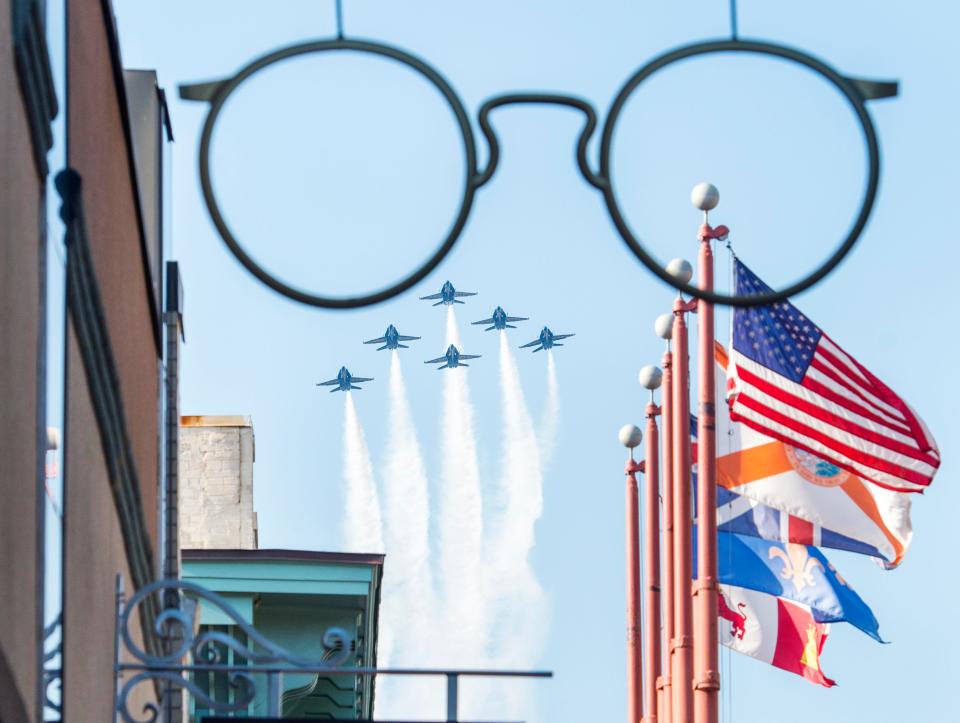
Here are a few terms to know before reading.
Center point: This traditionally indicates the center point of the runway. When not near a runway, this is a reference point the pilots use for primary alignment.
Angle of bank: This is a term showgoers don’t need to know to enjoy the show but it is referenced in the Blue Angel maneuver manual and indicates the angle between an aircraft’s vertical axis and the earth’s vertical plain that contains the aircraft’s longitudinal axis.
In other words, if you draw a horizontal line across the earth’s horizon and a vertical line coming out of the top of an aircraft, the angle measured between the earth’s horizon and the aircraft is considered the angle of bank or bank angle.
Flight line: The flight line is typically the part of an airport near its hangars where aircraft can be parked and serviced.
Delta Formation
The Delta formation is a flight pattern recognizable by just about anyone. The formation consists of several jets flying together in a “V” formation with each jet cascading higher than the one in front of it, using the forward jet to reduce wind resistance. It’s a formation also recognizable because it’s used by birds to migrate over long distances.
While the Delta formation isn’t a maneuver in the same vein as the others listed below, it’s easily one of the most recognizable and iconic visuals associated with the Blue Angels.
Delta Break Out
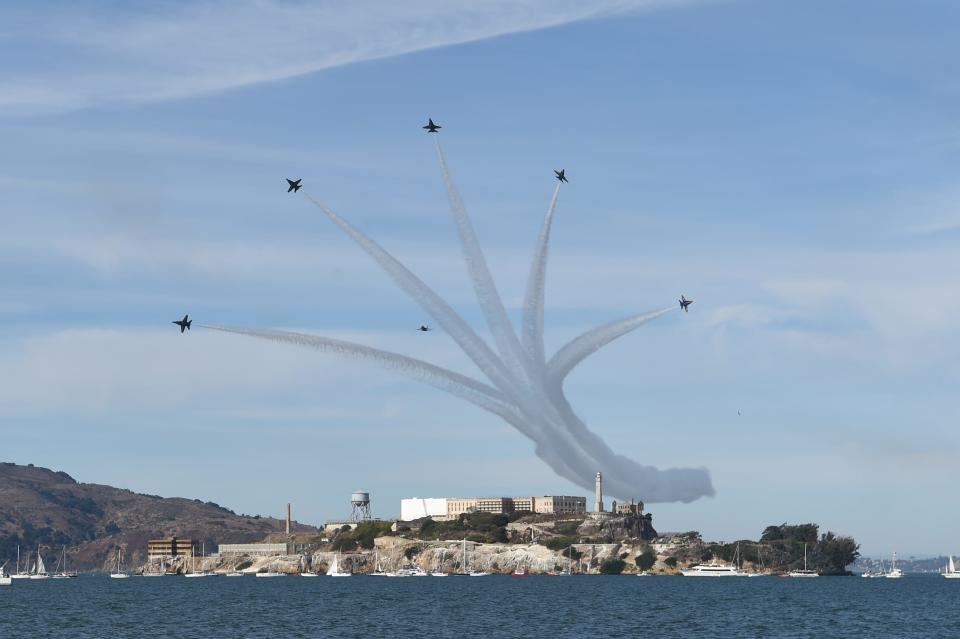
The Delta Breakout is a popular maneuver where the Blue Angels fly toward the crowd over the center point in delta formation before breaking apart in different directions above the crowd. The lead will pull up into a steady, 2G climb forward, the solos (No. 5 and No. 6) will pull outboard in a steady, 2G, 60-degree angle-of-bank that is offset by 90 degrees, the wingmen (No. 2 and No. 3) pull outboard in a steady 2G, 45-degree angle-of-bank offset by 45 degrees while the lead and slot continue straight and exit behind the crowd.
Diamond Echelon Parade
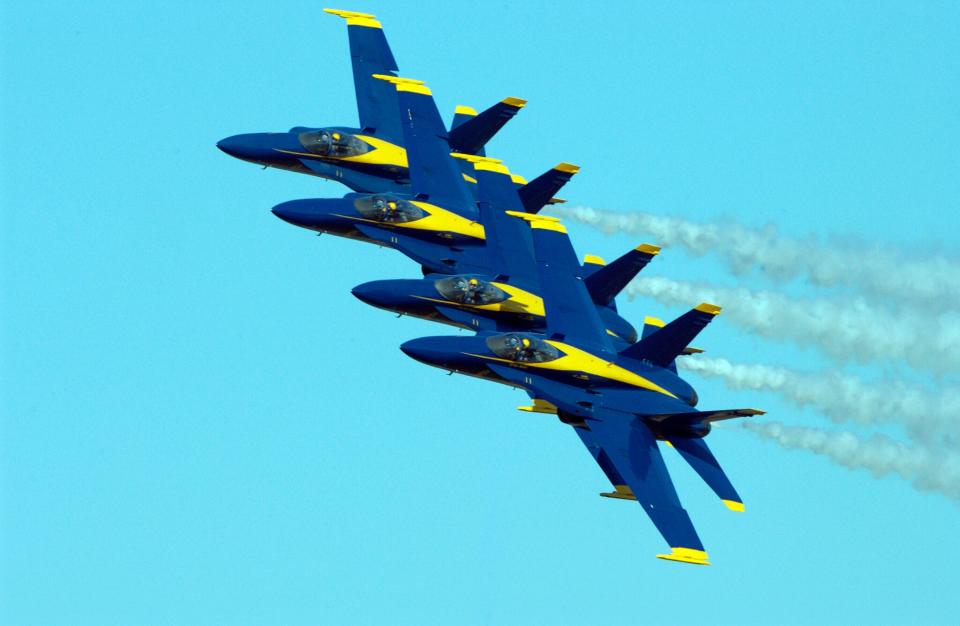
In right echelon, a diamond formation will execute a right-to-left, non-aerobatic circular pass at approximately 60-degree angle-of-bank that crosses over the center point at a minimum altitude of 200 feet.
Sneak Pass

The Sneak Pass is a crowd favorite. While the audience is still focusing on the diamond's left echelon roll, the two solo pilots perform a sneak pass at just under the speed of sound, one from the left of the crowd and one from behind. These stealthy flyovers are low altitude and a good reason to bring ear protection.
Fleur De Lis
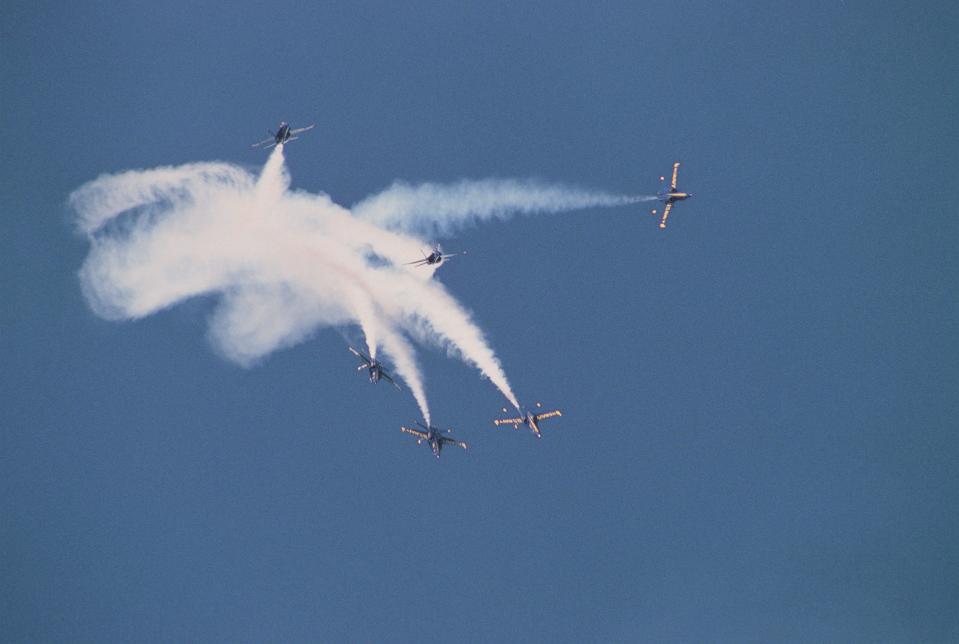
The Fleur de lis maneuver has the Blue Angels approaching the show line in a Double “V” formation with the six aircraft commencing a climb. All six aircraft will split simultaneously at approximately 2,000 feet before the center point. The two solos will execute 1.5 rolls and exit to the right of the crowd initially, then turn behind the crowd. The four aircraft in diamond formation then rendezvous during their looping maneuver over the center point and egress in diamond formation in front of the crowd.
Double Farvel
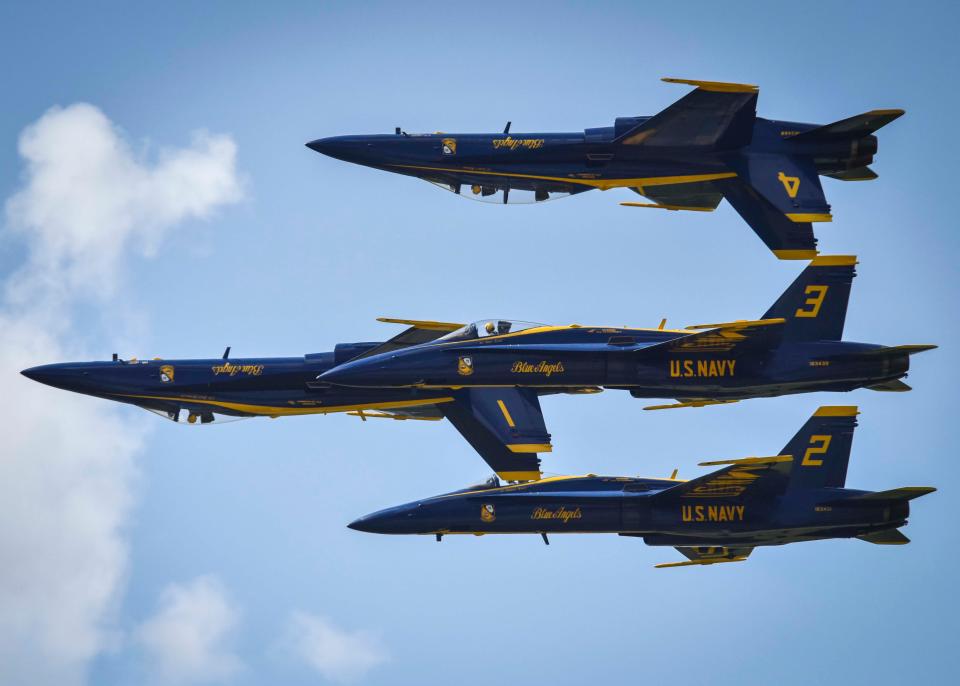
The lead and slot (No. 1 and No. 4) roll inverted simultaneously at the edge of the aerobatic box while No. 2 and No. 3 remain upright. The four jets then maintain a diamond formation as they perform a flat pass around 200 feet above the crowd. Right after the formation passes the center point, the lead and slot pilots roll upright in a climb.
Opposing Knife Edge
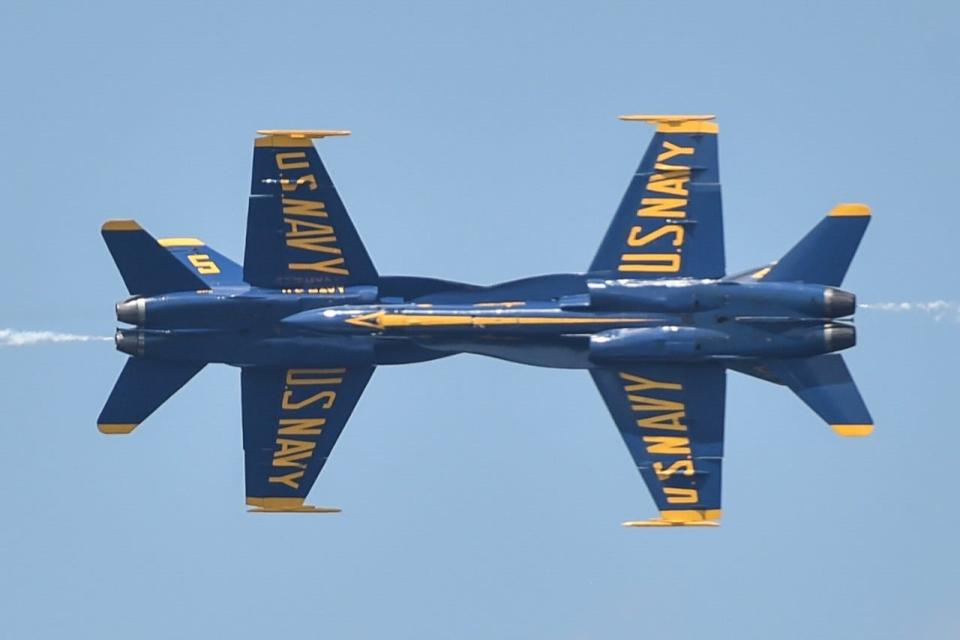
The Opposing Knife Edge pass has the solos approach the center point from opposite directions. Each pilot will roll their aircraft into a 90-degree angle-of-bank before passing each other on the center point. After the pass, both aircraft will roll upright and clear the front of the crowd.
Loop break cross
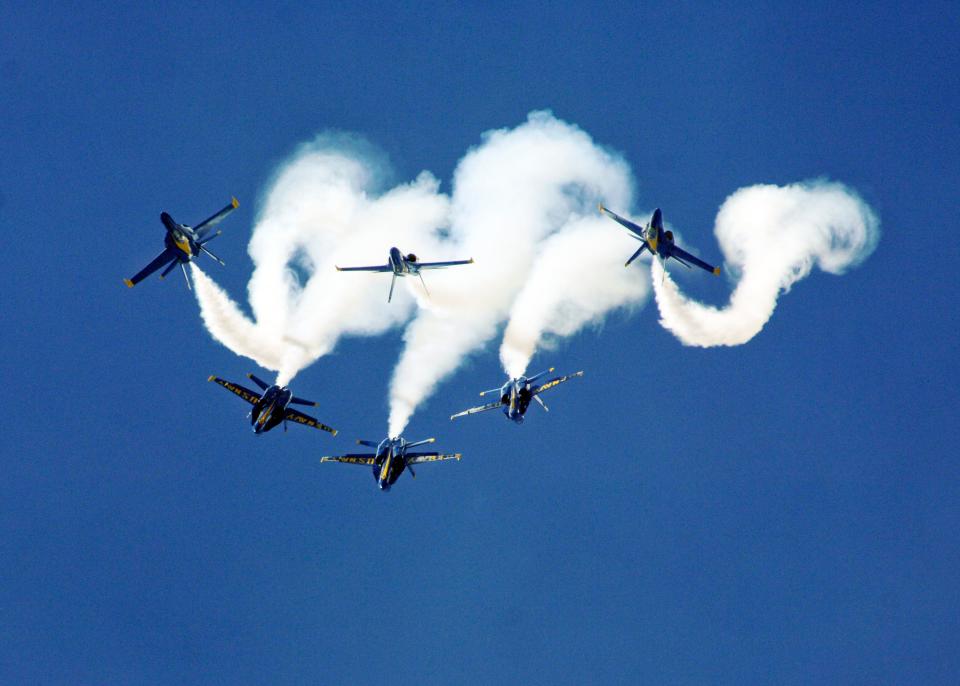
The jets cross over the center point in the Delta formation, all six jets in a triangle, where they execute a loop together. Before the loop is completed the three pilots who make up the back of the formation separate and head in the opposite direction. All six pilots then turn around and head back toward the center point where they will all cross at a speed of nearly 460 mph.
Vertical break

The pilots in diamond formation trail one another and climb at a vertical 90-degree angle, where they reform the Diamond. The Diamond then splits and each jet goes in a different direction.
The Fortus
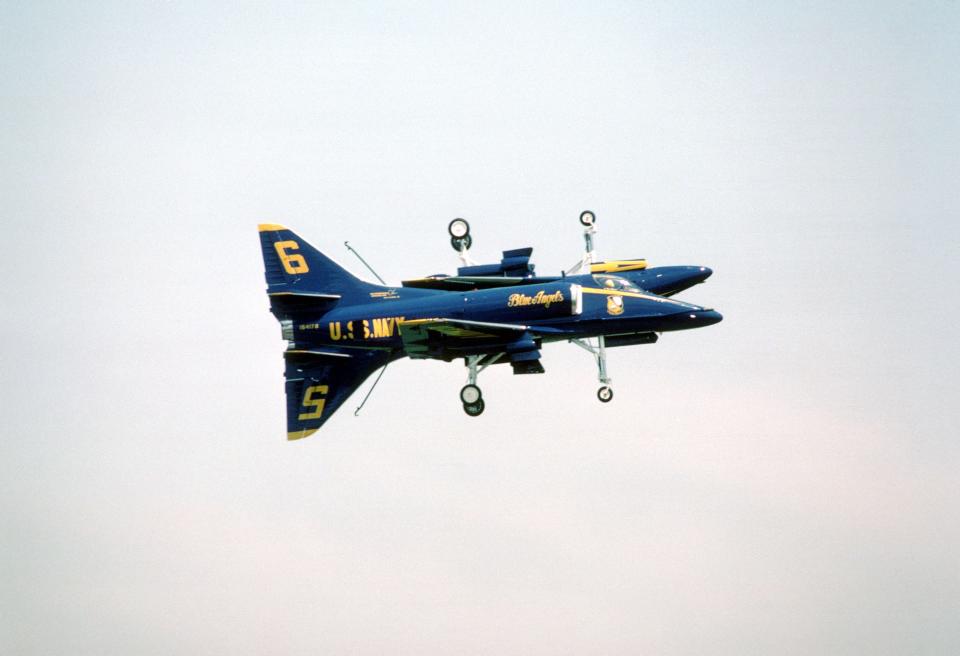
The solo jets fly side by side with their landing gear and tailhooks down. The No. 5 jet rolls to the inverted position, creating a mirror image for the crowd.
What planes do the Blue Angels fly?
In 2021, the Blue Angels transitioned from the Boeing F/A-18 Hornet, which the team has flown since 1986, to the Boeing F/A-18 Super Hornet. The new Super Hornets are 25% larger, can fly 40% further and remain on station 80% longer.
How fast do the Blue Angels fly?
The fastest the Blue Angels fly during an air show is 700 mph during its Sneak Pass maneuver. The slowest speed is around 120 mph during the Section High Alpha maneuver.
How close do the Blue Angels fly?
The diamond formation the Blue Angels fly in during the Diamond 360 maneuver has the jets flying about 18 inches from each other.
How low do the Blue Angels fly during an air show?
Not every air show is the same, and because safety is paramount, the range of maneuvers the team performs depends entirely upon the conditions at the time of the show. That said, in general, the infamous Sneak Pass is the closest they'll get to the ground. During this maneuver, the Lead Solo will "sneak" up on the crowd from behind and pass only 50 feet above it. Earbuds are recommended to protect your ears, but nothing will save you from the rumbling you'll feel in your chest as it passes overhead.
What is the most impressive move the Blue Angels perform?
The Blue Angels allow media and other selected civilians to participate in rides ahead of some shows. Anyone selected to participate has to pass a physical exam and get a sign-off from their doctor. During these rides, it's not uncommon for the rider to pass out at some point. All of this is to say that it's demanding enough just to sit in the cockpit. All of the maneuvers performed by the Blue Angels are impressive.
This article originally appeared on Pensacola News Journal: Blue Angels maneuvers, jets, how fast they fly and more
